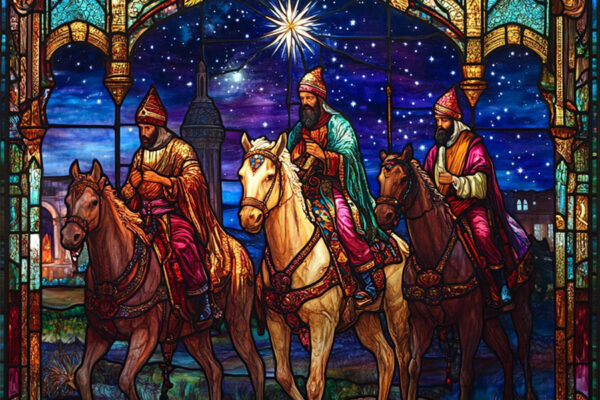The life of Jesus
On certain days, when the sunlight hits just right, a rich and vibrant array of colors light up the St. Paul Sanctuary. The light filters into reds, blues, yellows, and greens through the Ascension window. Originally, stained glass windows were used as teaching companions for those who could not read. Today, they offer a history lesson and artistic interpretation of the story of Jesus. In addition to the story told, each window has symbols that represent special messages.
“St. Paul’s stained glass windows are beautiful. They have a radiance that delights the senses and a story that stirs the soul,” the late Harvey Prinz wrote about the windows.
THE BIRTH OF JESUS
Symbols: Lily, carnation, star
Mary gently wraps her baby boy with bands of cloth. Joseph stands beside a shaft of light, trying to grasp the wonder of an angel chorus just described by the shepherd. The kneeling shepherd bows his weary head. A little lamb looks up. The carnation represents pure love.
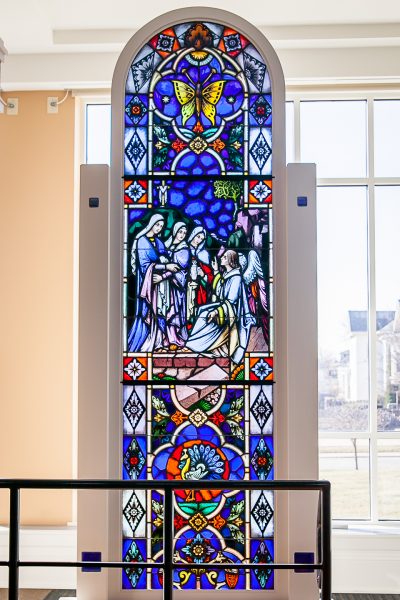
JESUS IN THE TEMPLE
Symbols: Lotus, star, lamp
Early in life, Jesus is more at home in the temple than his parental home. Mary and Joseph discover Jesus in the temple with the religious scholars. The white lotus is depicted because it blossoms with remarkable beauty untouched by the impurity of its environment.
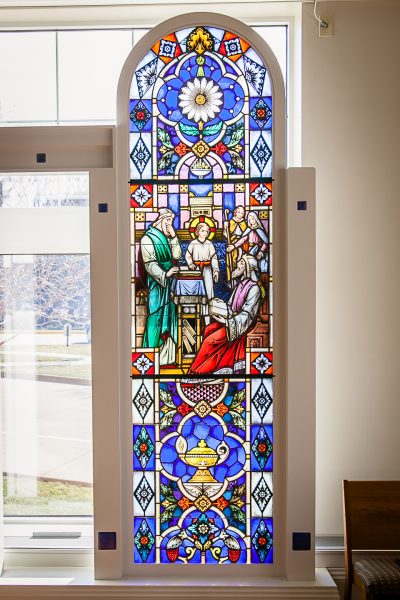
BAPTISM OF OUR LORD
Symbols: Phoenix, nimbus, shamrock, shell
John baptizes with water, but he tells of a greater one who will come and baptize with the Holy Spirit. Although he has no sins to confess, he asks John to baptize him in solidarity with us. A shamrock with three leaves symbolizes the Holy Trinity.
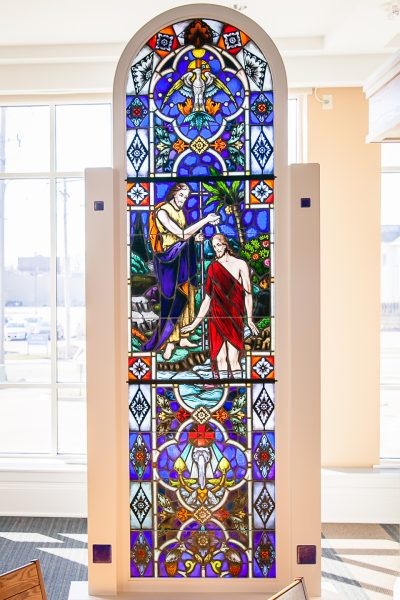
TEMPTATION OF JESUS
Symbols: Oak tree, chi rho, world, dragon
The artist of this window depicts a scary wilderness. A volcano steams. Lightening strikes. A vulture peers menacingly from a rock perch. Two lions and a snake have their eyes on Jesus. The oak tree represents the wood from which Jesus’ cross would be made, his enduring adversity, and testing in this earthly life.
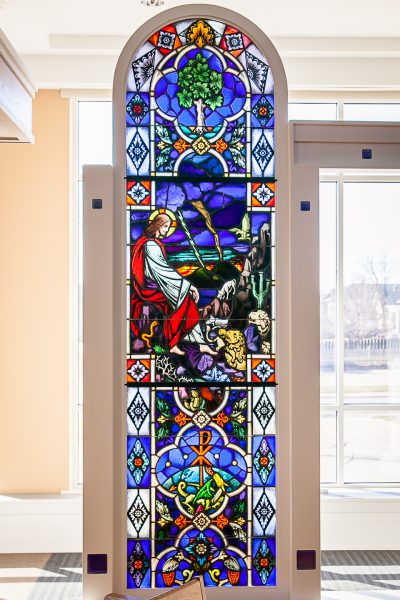
JESUS THE TEACHER
Symbols: Bible, candle, padlocked door
Jesus is a gifted teacher. He inspires and touches lives as no one else. He also challenged others, and made enemies along the way. Among his followers, Jesus opens doors of a new way to live in the world. Jesus suggests that behind the padlocked door is a joyful homecoming for all who are lost.
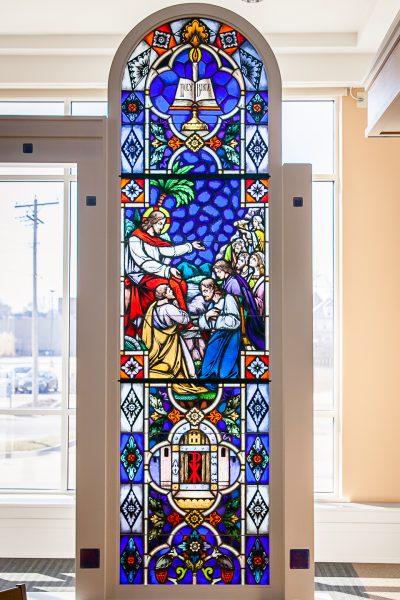
TRANSFIGURATION
Symbols: Stone tablets, grapes, fiery chariot
“Shine Jesus, shine, fill this land with the Father’s glory.” This hymn could be a theme for a mountaintop event for Jesus, Peter, James, and John. We call it the transfiguration because Jesus’ clothing suddenly becomes dazzling white. The grapes represent the land God promised the wandering Israelites.
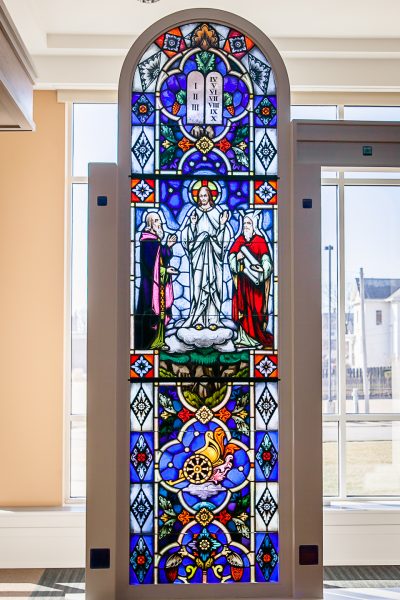
JESUS IN JERUSALEM
Symbols: Light, palms, crown, scepter
Jesus rides into Jerusalem for the Passover. This fulfills an ancient image from the prophet Zechariah of the Messiah arriving on a donkey. “Here comes the king,” shouts the palm-waving crowd. The palm branches remind us of the victory of God’s love for the world in Jesus’ suffering.
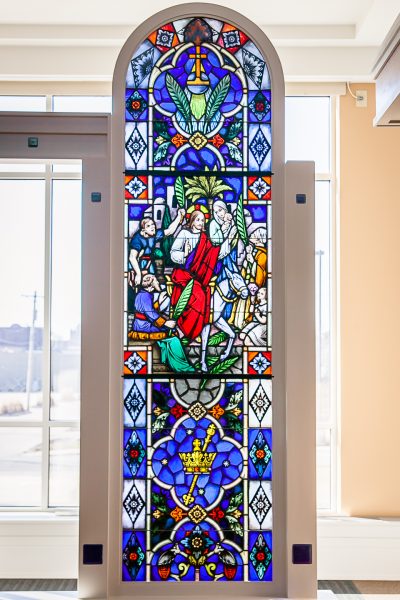
JESUS IN THE GARDEN
Symbols: Red cross, cup, sword, ear, sheath
Jesus goes to the Garden of Gethsemane to pray – a moment of great restlessness and anxiety. In the garden, he experiences the agony of anticipated suffering. The sword, sheath, and ear remind us of the betrayal of Judas and the capture of Jesus by the mob in the garden.
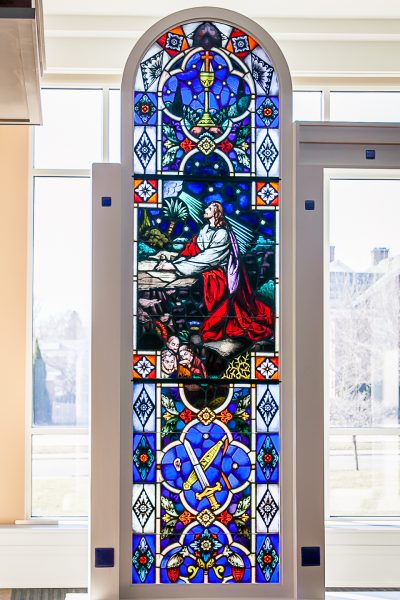
CRUCIFIXION OF JESUS
Symbols: Pelican, fish
On the cross, Jesus prays for his persecutors, comforts the thief dying at his side, and provides for care for his mother. Death comes as he prays to God. Legend says the pelican feeds its young with its own blood, and then dies. The early church saw this as a parallel to the life of Jesus.
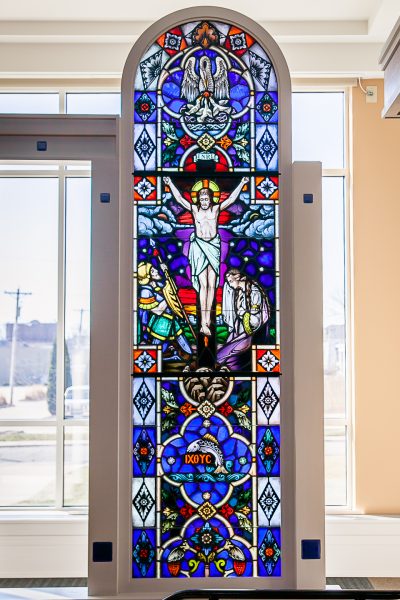
RESURRECTION OF JESUS
Symbols: Butterfly, antenna shell, roses, peacock
Mary Magdalene, Mary the mother of James, and Salome are bringing burial spices to anoint the dead body of Jesus. A closer look reveals tinges of bloodshot red from sobbing. They see the tombstone cracked, entrance open, and a young messenger of God in white. The butterfly symbolizes resurrected life.

ASCENSION OF OUR LORD
Symbols: Vine, branches, fruit, flowers
Forty days after his resurrection, Jesus ascends into heaven. We feed the hungry, comfort the sick and wounded hearts, and seek justice for those who cannot. It is Christ who works through us, and the Spirit who empowers us. Vines, branches, fruit, and flowers symbolize the relationship between followers and Jesus.
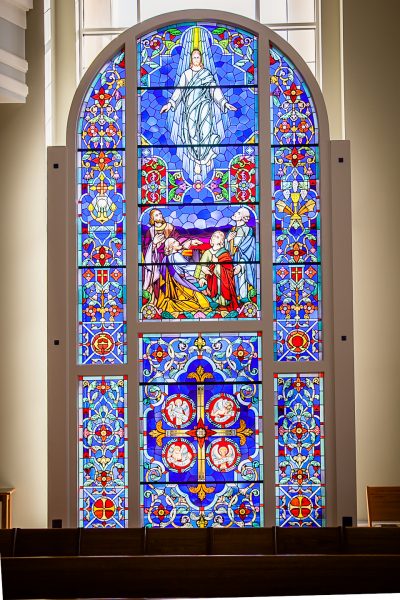
TIMELINE: WINDOW HISTORY
1950: Ground-breaking for the new St. Paul Lutheran at Brady and Lombard streets. Father-son pastors J.A. and Emerson Miller developed a 10-window life of Jesus theme, with an ascension window above the altar.
1952: The former Columbia Stained Glass Company of Milwaukee created the windows at a cost of $12,000.
1985: In a remodeling of the 1952 sanctuary, Gospel symbols were added to complete the lower part of the ascension window. The work was completed by Potente of Kenosha, Wisconsin.
2007: The windows were moved into the new sanctuary as an interior wall of art.
A booklet detailing information about St. Paul’s stained glass windows, along with devotional thoughts, is available in the Book Corner. The booklet was created by Harvey Prinz, who was a Lutheran pastor and bishop, with credit to Joyce and Paul Bohnsack, “longtime stewards of the St. Paul stained glass stories.”



